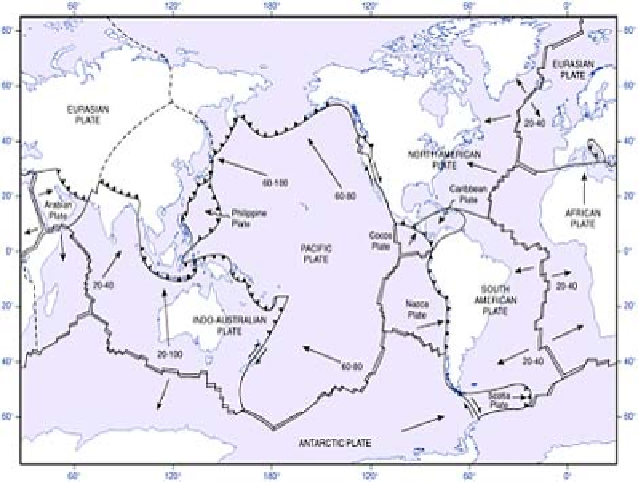Environmental Engineering Reference
In-Depth Information
PLATES AND PLATE MOTION
Cool, outer lithosphere does not form unbroken crust but is divided into a mosaic of
interlocking rigid
plates
with active boundaries and relatively stable interiors. Each plate
consists of rigid continental and/or ocean crust and its underlying upper mantle. The
global mosaic is dominated by seven major plates, individually 10
7-8
km
2
in area, and a
further six minor plates, each an order of magnitude smaller in the range 10
6-7
km
2
. A
number of microplates assist in articulating the differential movement of major plates
over Earth's curved surface (Figure 10.4). Plate names suggest a series of separate
oceanic and continental plates but the reality is more complex. Although American
Pacific coastlines closely follow the eastern boundary of the essentially oceanic Pacific,
Cocos and Nazca plates, two plates account for each American continent and its
respective western half of the Atlantic Ocean. In contrast, the Eurasian plate is mostly
continental but includes the north-east Atlantic and eastern Arctic Oceans, whereas the
Eurasian land mass includes continental fragments of the African, Indo-Australian and
other small plates.
Continents reflect the accretion of terranes from more than one plate and may
themselves eventually rift apart at new plate boundaries. Continental collisions
suture
, or
weld together, distinct terranes and parts of the Alpine and Himalayan mountain systems
of the modern Eurasian plate mark such sutures formed as the Tethys Sea closed. The
closure of the long-gone Iapetus Ocean in the Lower
Figure 10.4
Earth's lithospheric plates, showing constructive
margins (parallel lines), destructive margins (toothed lines;
teeth point in direction of subduction) and transform margins

